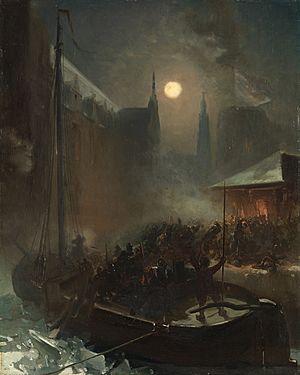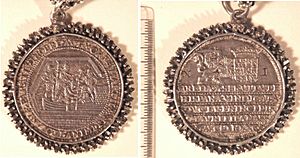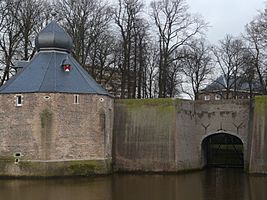Capture of Breda (1590) facts for kids
Quick facts for kids Capture of Breda (1590) |
|||||||
|---|---|---|---|---|---|---|---|
| Part of the Eighty Years' War | |||||||
 The Peat boat at Breda by Charles Rochussen |
|||||||
|
|||||||
| Belligerents | |||||||
| Commanders and leaders | |||||||
| Strength | |||||||
| 1,700 (70 in assault) | 600 | ||||||
| Casualties and losses | |||||||
| One soldier drowned | 40 killed or wounded | ||||||
The capture of Breda was a short but important battle. It happened during the Eighty Years' War and the Anglo–Spanish War. A Dutch and English army, led by Maurice of Nassau, took over the well-protected city of Breda.
They used a very clever trick, much like the famous Trojan horse story. A small group of soldiers hid inside a boat carrying peat (a type of fuel). They entered Breda this way. This surprise attack allowed them to capture the city with very few injuries. It was a big moment in the war. It helped Maurice's forces start winning more battles.
Contents
Background
The city of Breda is in the Netherlands. It sits where the Aa and Mark rivers meet. Breda was a very important city in the area. It was also well-fortified. A defensive moat (a deep ditch filled with water) surrounded the city. This moat was fed by the Mark river.
Spanish forces had controlled Breda since 1581. About 500 foot soldiers and 100 cavalry (soldiers on horseback) were stationed there. Most of these troops were Italian and Spanish. They served the Spanish Empire. Eduardo Lanzavecchia was the governor of Breda. He was also in charge of another city called Geertruidenberg. He was busy building defenses in both cities. He knew they might be attacked soon. In early 1590, he was in Geertruidenberg. His nephew, Paolo Lanzavecchia, was acting governor of Breda while he was away.
The Peat Barge Trick
In February 1590, a brave nobleman named Charles de Heraugiere had a secret mission. He was ordered by Maurice of Nassau to scout Breda. He dressed as a fisherman to try and enter the city. He wanted to find out how strong its defenses were. He also wanted to see how many soldiers were there.
Heraugiere met Adriaen van Bergen. Adriaen was a Dutch trader who often went in and out of Breda. He used a barge (a flat-bottomed boat) to carry winter fuel, like peat. Heraugiere and a few soldiers hid among the peat in Adriaen's barge. They found it surprisingly easy to get in. None of the Spanish guards checked the boat carefully. Once inside Breda, they quickly left the boat. They made sure to leave enough peat to stay hidden. Heraugiere quickly realized this "Trojan Horse" idea was perfect. He reported it to Maurice as soon as he returned.
Maurice of Nassau loved the plan and gave his approval. He ordered the operation to go ahead, but it had to be kept a total secret. On February 25, Charles de Heraugiere was chosen to lead the secret attack. He had 68 hand-picked Dutch and English soldiers with him. They waited near the Mark river for van Bergen's boat. Captains Logier, Fervet, and Lieutenant Matthew Held were also with them. That same day, Maurice of Nassau, Francis Vere, and Count Hohenlohe arrived in Willemstad. They had 800 Dutch and 600 English soldiers, plus 300 cavalry. Willemstad was about 30 kilometers from Breda. They would wait there for Heraugiere's signal.
On February 26, Heraugiere and his men got on van Bergen's boat. But van Bergen was sick or overslept. So, he sent his two nephews to steer the barge instead. They sailed towards Breda on the Mark river. The Dutch winter was extremely cold. Ice made it hard to move the boat. This delayed their trip by several days. Finally, by Saturday evening, they reached Breda. They were at the outer gates early the next morning.
The Surprise Attack
The soldiers stayed hidden under the piles of peat. They entered the city without being checked, just as planned. Once they had tricked the city guards, Heraugiere sent the signal to Maurice. Maurice then immediately started marching his troops towards Breda.
At dawn on Sunday, March 4, the hidden attackers came out of the boat. They split into two groups. Heraugiere's group attacked the guard post. Fervet's group tried to take control of the fort's weapons storage. The Italian soldiers guarding the city were completely surprised. The attackers moved very quickly. They killed forty defenders without losing any of their own men. The Italian and Spanish soldiers were so shocked that they ran away into the city streets.
Before sunrise, Count Hohenlohe arrived at Breda's gates with the Dutch cavalry. Maurice of Nassau followed him with the main army. Count Solms and Francis Vere were also with them. By this time, Heraugiere's men had already taken control of most of the city.
Surrender
The Breda garrison (the soldiers defending the city) was completely surrounded. They were also in total confusion. Paolo Lanzavecchia, the acting governor, talked with the attackers. They agreed on the terms for the city's surrender:
- The city would not be looted. In return, each soldier who took part in the attack would get two months' pay. However, this amount ended up being too much (100,000 florins). Many soldiers who arrived after the surrender also claimed to have been part of the attack.
- Citizens who wanted to leave the city would be allowed to do so. Their religious beliefs would be respected.
- Those who wanted to stay would not be harmed. Their belongings would also be left alone.
What Happened Next
The capture of Breda by the Dutch and English troops was a big shock for the Spanish. They had thought the city was safe. The Duke of Parma, Alexander Farnese, was furious. He was angry about how easily the Italian troops had given up the city. He ordered three captains who were in charge of Breda's defense to be executed. A fourth officer was kicked out of the army. Finally, Eduardo Lanzavecchia lost his job as governor of Geertruidenberg.
The Dutch celebrated the capture of Breda. It was a huge success with almost no casualties. For years, the Dutch had mostly been defending themselves. But now, with Spanish forces busy fighting Protestants in France, the Dutch and English had finally won a big offensive battle. Breda was very important strategically. People celebrated across the United Provinces. Many special coins were made to remember the victory.
After taking Breda, Maurice of Nassau used it as a base. From there, he went on to conquer other places. These included Elshout, Fort Crèvecoeur, Steenbergen, Roosendaal, and Oosterhout. Charles de Heraugiere was made governor of Breda because of his brave plan. He also received a gold medal. The bargemen who helped were given money for life. Many of the soldiers who took part in the capture also received rewards.
Breda stayed in Dutch hands until 1625. Then, Spanish soldiers led by Ambrosio Spinola managed to recapture it after a long siege. But in 1637, after another siege, Breda returned to Dutch control for good.
Legacy
Around 1610, construction began on the Spanish Gate, or "Spandjaardsgat." This gate was built to remember the successful capture of Breda in 1590. The gate also helped to keep the water in the castle's moat fresh.
Images for kids
-
The peat boat, by Hugo Grotius
See also
 In Spanish: Toma de Breda (1590) para niños
In Spanish: Toma de Breda (1590) para niños





